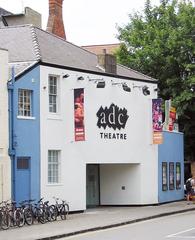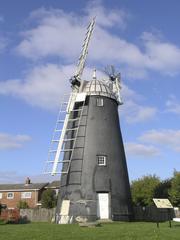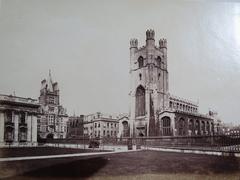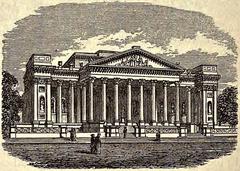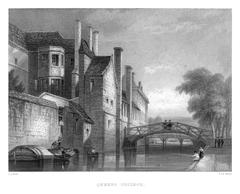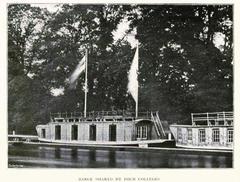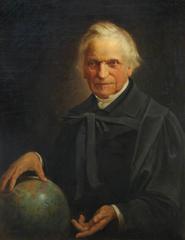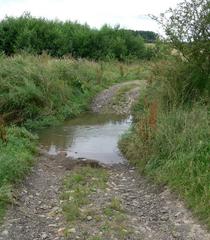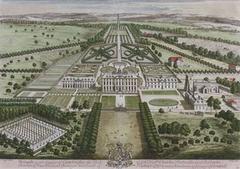
Scott Polar Research Institute Visiting Hours, Tickets, and Cambridge Historical Sites Guide
Date: 03/07/2025
Introduction
The Scott Polar Research Institute (SPRI) in Cambridge, United Kingdom, is a world-renowned center dedicated to the history, science, and culture of the Earth’s polar regions. Established in 1920 as a memorial to Captain Robert Falcon Scott and his Antarctic expedition team, SPRI combines a rich heritage of polar exploration with leading-edge research in glaciology, climate science, and environmental studies. Its Polar Museum—located on Lensfield Road—offers free admission and is open Tuesday through Saturday, making it an accessible and enriching destination for visitors of all ages. This comprehensive guide covers everything you need to know about visiting SPRI, including opening hours, tickets, accessibility, nearby historical sites, and tips to make the most of your visit.
For up-to-date information on opening hours, exhibitions, and visitor details, consult the Scott Polar Research Institute Official Website.
Table of Contents
- Introduction
- Visiting Hours and Tickets
- Directions and Accessibility
- Museum Highlights
- Special Features and Visitor Tips
- Visual and Virtual Resources
- Frequently Asked Questions (FAQs)
- Nearby Cambridge Historical Sites
- Planning Your Visit: Practical Tips
- Conclusion and Call to Action
- References and Further Reading
Visiting Hours and Tickets
- Opening Days: Tuesday to Saturday (closed Sundays, Mondays, and public holidays)
- Opening Hours: 10:00 am – 4:00 pm (last admission 3:45 pm)
- Admission: Free for all visitors; donations are encouraged to support ongoing museum programs and preservation efforts.
- Guided Tours: Available for groups by advance booking, with a suggested donation or small fee. Educational and special-interest tours can be arranged via the SPRI website.
For the latest details or to book a group visit, check the official SPRI website.
Directions and Accessibility
Location: Lensfield Road, Cambridge, Cambridgeshire, England, CB2 1ER (SPRI official website)
- By Train: Cambridge Station is about a 15-minute walk from SPRI.
- By Bus: Citi 1, 3, and 7 bus routes stop near Lensfield Road (Exploring Cambridge).
- By Car: Limited parking is available; Park & Ride and public car parks are recommended.
Accessibility:
- The building is wheelchair accessible, with ramps and adapted restrooms.
- Staff can assist visitors with special requirements.
- No cloakroom; please travel light.
- Accessible seating is available throughout.
Museum Highlights
Founding and Legacy
SPRI was established in 1920 to honor Captain Robert Falcon Scott and his companions who perished during the Terra Nova Antarctic expedition. Under Frank Debenham’s leadership, the institute became a hub for polar research and the preservation of expedition artifacts, diaries, and photographs.
Architecture and Symbolism
The museum’s historic building features notable elements such as a bust of Captain Scott above the entrance and a statue by Kathleen Scott in the garden. Latin inscriptions and a ceiling map celebrate the enduring quest for polar knowledge.
Collections and Research
- Artifacts from Scott, Shackleton, and other legendary explorers, including personal letters and equipment.
- The UK’s largest public collection of Inuit art and cultural items.
- Scientific instruments tracing the evolution of polar research.
- Extensive archives supporting international research in glaciology and environmental science.
The Polar Museum’s Public Role
A major redevelopment in 2010 enhanced the museum’s interactive exhibits and public programs. Engaging displays, hands-on activities, and rotating exhibitions such as “Painting the Poles” and “Hidden Histories” offer fresh insights into polar heritage (SPRI Exhibitions).
Library and Archives
SPRI’s library is one of the world’s most comprehensive polar resources, spanning material from the 16th century to present-day research. The museum fosters a vibrant academic community, from daily afternoon teas (announced by the bell from Scott’s ship) to international scholarly collaboration.
SPRI in Modern Science
Today, SPRI leads research on glaciology, climate change, and the impacts of environmental challenges in the Arctic and Antarctic. Ongoing projects and partnerships ensure SPRI remains at the forefront of scientific discovery and public education.
Special Features and Visitor Tips
- Guided Tours: Available by arrangement; ideal for groups and schools.
- Photography: Non-flash photography is allowed for personal use. Flash is restricted in some exhibits.
- Events: Lectures, workshops, and temporary exhibitions are hosted year-round. Check the SPRI news page for upcoming events.
- Family-Friendly: Interactive displays, educational programs, and handling sessions make it an excellent choice for families.
- Shop: A small shop offers books, souvenirs, and educational materials.
Visual and Virtual Resources
- Online Collections: Explore digital archives, including the “Shackleton Online” archive (SPRI Collections).
- Virtual Tours: Preview the museum’s highlights and exhibitions online.
- Accessibility: High-quality images feature descriptive alt tags (e.g., “Scott’s last letters,” “Inuit traditional clothing”) for an inclusive digital experience.
Frequently Asked Questions (FAQs)
Q: What are the Scott Polar Research Institute’s visiting hours?
A: Tuesday to Saturday, 10:00 am to 4:00 pm; closed Sundays, Mondays, and public holidays.
Q: Is there an admission fee?
A: Admission is free; donations are welcome.
Q: Are guided tours available?
A: Yes, for groups and educational visits by prior arrangement.
Q: Is the museum wheelchair accessible?
A: Yes, with ramps and adapted restrooms; contact the museum for specific needs.
Q: Can children visit?
A: Absolutely. The museum is family-friendly, with activities and resources for young visitors.
Q: Is photography allowed?
A: Non-flash photography is allowed for personal use.
Nearby Cambridge Historical Sites
The museum is ideally located for exploring other renowned Cambridge attractions:
- Fitzwilliam Museum: Fine art and antiquities (Museums Cambridge).
- King’s College Chapel: Iconic Gothic architecture.
- Cambridge University Botanic Garden: Historic gardens nearby.
- Museum of Archaeology and Anthropology and Sedgwick Museum of Earth Sciences: Both within walking distance.
Cambridge’s city center also offers a variety of dining options and accommodations (Britain Express).
Planning Your Visit: Practical Tips
- Best Time to Visit: Weekday mornings are quieter.
- Duration: Most visitors spend 1–2 hours in the museum.
- Group Visits: Book in advance for groups (school or large parties).
- Check for Updates: Visit the official SPRI website for current exhibitions and events.
- Combine Visits: Take advantage of SPRI’s proximity to other University of Cambridge museums and historic sites.
Conclusion and Call to Action
The Scott Polar Research Institute and Polar Museum offer a unique and impactful experience, blending history, science, and cultural discovery. With free admission, accessible facilities, and world-class collections, SPRI is a must-see destination for visitors to Cambridge. Whether you are fascinated by polar exploration, interested in climate science, or exploring the city’s historic treasures, SPRI provides a welcoming and enriching environment.
Plan your visit today by checking the Scott Polar Research Institute’s official website. Stay updated by following SPRI’s social media channels and subscribing to their newsletter. To enhance your museum experience and explore more Cambridge sites, download the Audiala app for curated digital guides.
References and Further Reading
- Scott Polar Research Institute Visiting Hours, Tickets, and Historical Insights in Cambridge, 2025, Scott Polar Research Institute (https://www.spri.cam.ac.uk/museum/)
- Visiting the Scott Polar Research Institute: Hours, Tickets, and Exploring Cambridge’s Polar Heritage, 2025, Cambridge Visitor Guides (https://www.spri.cam.ac.uk/museum/)
- Visiting The Polar Museum in Cambridge: Hours, Tickets, Exhibits, and Family Activities, 2025, University of Cambridge Museums (https://www.spri.cam.ac.uk/museum/)
- Scott Polar Research Institute Visiting Hours, Tickets, and Cambridge Historical Sites Guide, 2025, Britain Express and Museums Cambridge (https://www.spri.cam.ac.uk/museum/)









